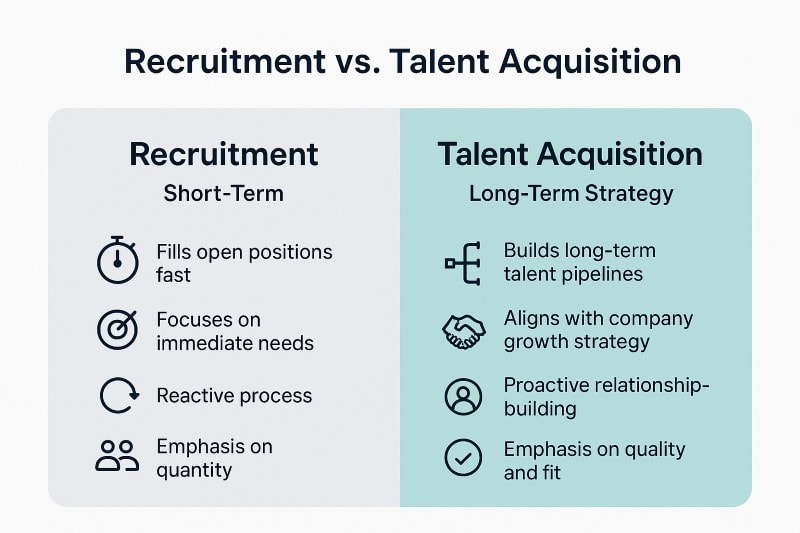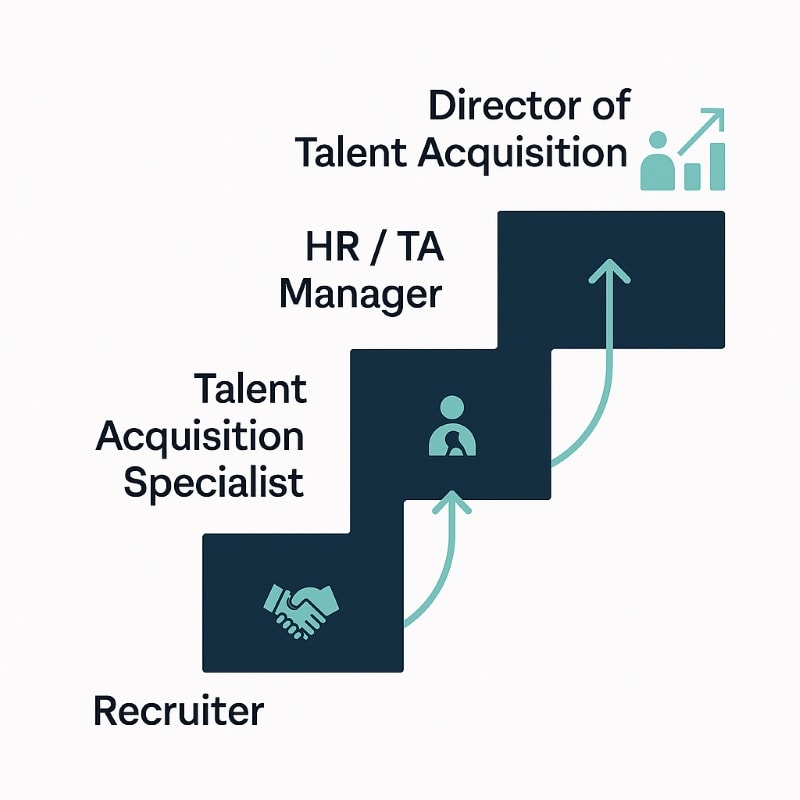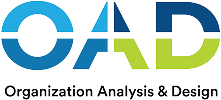Hiring the right people can make or break a company’s growth — yet many organizations still underestimate the importance of a dedicated talent acquisition position. Think of the startup that scaled too fast — hiring whoever was available — only to collapse under culture clashes and constant turnover. Far more than just filling open roles, this role shapes long-term hiring strategies, employer branding, and workforce planning. When done well, talent acquisition becomes a competitive advantage that drives business success.
Table of Contents
- Defining the Talent Acquisition Position
- The Core Responsibilities of Talent Acquisition Professionals
- Strategic Impact on Business Goals
- Talent Acquisition vs. Traditional Recruitment Strategies
- Key Skills and Competencies of Talent Acquisition Professionals
- Types of Recruitment Jobs in Talent Acquisition
- Talent Acquisition Manager vs. Specialist: What’s the Difference?
- Modern Talent Acquisition Strategies That Work
- How Talent Acquisition Aligns with Talent Management and HR Operations
- Career Development Paths in Talent Acquisition
- Why the Talent Acquisition Position Is Critical for High-Growth Companies
- Conclusion: Turning Talent Acquisition Into a Competitive Advantage
Defining the Talent Acquisition Position
At its core, a talent acquisition position is about much more than recruitment. While recruitment often focuses on filling open positions quickly, talent acquisition is a long-term, strategic function that builds a pipeline of qualified candidates aligned with business goals. A talent acquisition strategy is a comprehensive, long-term plan for attracting, engaging, and hiring top candidates, and is central to the role.
A professional in a talent acquisition role is responsible for identifying future hiring needs, implementing sourcing strategies, and ensuring a positive candidate experience. Talent acquisition is an ongoing strategy, involving continuous efforts to build, source, recruit, and onboard talent, rather than a one-time effort. At OAD, we see this mistake all the time: leaders treat hiring like putting out fires instead of building a long-term engine for growth. This position bridges the gap between day-to-day hiring practices and broader organizational effectiveness, making it a cornerstone of modern human resources management.
Unlike transactional recruiters, talent acquisition professionals evaluate not just who can do the job today, but who has the skills, mindset, and cultural fit to thrive tomorrow. Candidates today don’t just ask about salary — they Google Glassdoor reviews at 2 a.m. A vague culture statement won’t cut it; one bad review can undo months of employer branding. Jeff Bezos once said, ‘Your brand is what people say about you when you’re not in the room.’ Culture works the same way in hiring — it’s the silent deal-breaker or deal-maker. By focusing on both immediate recruitment needs and future workforce planning, they play a key role in shaping a company’s growth trajectory.
Most talent acquisition positions require at least a bachelor’s degree in human resources, business, or a related field.

The Core Responsibilities of Talent Acquisition Professionals
A talent acquisition specialist or manager carries a wide range of responsibilities that extend beyond simply posting jobs and reviewing resumes. Their role requires balancing operational efficiency with strategic foresight.
First, they collaborate with hiring managers and leaders across various departments to understand staffing needs and define what the ideal candidate looks like. From there, they craft compelling job postings that not only outline required technical skills but also highlight the company’s culture and growth opportunities. These postings are specifically designed to attract candidates by showcasing the company’s strengths and unique opportunities.
Second, they manage the interview process and candidate communications. Using tools like applicant tracking systems (ATS), they ensure that job seekers move smoothly through the hiring pipeline while maintaining clear communication and a positive candidate experience. Research shows people remember negative interactions twice as strongly as positive ones — so a single clunky interview can tank your entire employer brand.
Finally, they are responsible for evaluating outcomes. By monitoring recruitment metrics and analyzing which hiring strategies work best, talent acquisition professionals continuously refine processes to attract and retain top talent. LinkedIn’s Global Recruiting Trends report found that 70% of hiring managers believe data-driven recruiting is the future. At OAD, we go further — pairing data with behavioral science so you don’t just track numbers, you predict outcomes.
Strategic Impact on Business Goals
A strong talent acquisition position does more than fill vacancies — it directly influences an organization’s ability to achieve its business goals. By aligning hiring practices with long-term strategy, talent acquisition professionals help companies scale with the right people in the right roles.
One of their biggest contributions is enhancing employer branding. From the language in job postings to visibility at career fairs and industry events, they ensure the company is seen as an employer of choice. This not only attracts top candidates but also improves overall candidate experience, which strengthens reputation in the market. There are a variety of talent acquisition jobs, such as Talent Acquisition Specialist and Recruiter, each contributing to the overall success of the organization’s hiring strategy.
They also play a vital role in workforce planning and future hiring. By analyzing recruitment metrics and industry trends, talent acquisition professionals anticipate staffing needs and build proactive pipelines of qualified candidates. This reduces the risk of last-minute, reactive hiring that can lead to costly mismatches.
It’s the difference between the Golden State Warriors drafting talent for a season versus building a dynasty — short-term wins versus sustained dominance. Talent acquisition professionals often collaborate with HR on performance management processes, such as appraisals and ongoing feedback, to ensure new hires meet organizational standards and contribute to talent development. Companies that invest in this role often see reduced turnover, stronger culture, and a consistent ability to attract top talent in competitive markets.

Talent Acquisition vs. Traditional Recruitment Strategies
Although the terms are often used interchangeably, talent acquisition and recruitment represent two very different approaches. Recruitment is primarily about speed — filling a vacancy as quickly as possible to keep operations running. In contrast, a talent acquisition position takes a broader, more strategic mindset, focusing on building long-term pipelines of qualified candidates.
Traditional recruitment strategies usually rely on job postings and inbound applicants. While effective in the short term, this method often limits access to top candidates, especially in competitive or specialized industries.
Talent acquisition professionals go further. They implement sourcing strategies such as leveraging LinkedIn Recruiter, attending industry events, or engaging with job seekers at career fairs. They often engage in full cycle recruiting, managing every stage of the hiring process from sourcing and evaluating candidates to extending offers and onboarding. This proactive approach ensures that organizations have access to the right talent before a vacancy even arises.
In today’s dynamic environment, companies that rely solely on reactive recruitment risk falling behind. Imagine a biotech firm suddenly needing specialized engineers — but with no pipeline in place, they’re stuck competing for the same three candidates as everyone else. By embedding talent acquisition into their long-term hiring strategies, businesses strengthen their ability to compete, adapt, and grow.

Key Skills and Competencies of Talent Acquisition Professionals
Excelling in a talent acquisition role requires a balance of hard and soft skills. On the technical side, professionals must be adept with modern recruiting tools such as applicant tracking systems, LinkedIn Recruiter, and other sourcing platforms. These tools enable them to streamline hiring processes, manage candidate data, and identify top talent more efficiently. Attending job fairs is another important way talent acquisition professionals connect with potential candidates and expand their sourcing channels.
Equally important are soft skills. Strong organizational skills help them manage multiple hiring processes across cross functional teams, while a strategic mindset allows them to align recruitment with broader business goals. Clear and excellent communication is essential, ensuring a smooth exchange between candidates, hiring managers, and leadership.
Because talent acquisition professionals operate in a dynamic environment, adaptability is also critical. We’ve seen companies cling to outdated hiring playbooks — only to realize too late that their competitors have already moved on to predictive analytics and AI-driven sourcing. Industry trends, workforce demands, and new technologies evolve rapidly — those who thrive in this role combine a strong ability to analyze current practices with a commitment to continuous improvement.

Types of Recruitment Jobs in Talent Acquisition
Talent acquisition isn’t a single role — it’s a collection of specialized positions that work together to attract, engage, and hire the right people. Within an effective talent acquisition team, each job serves a distinct purpose, ensuring the entire recruitment process is both efficient and strategic.
At the core are talent acquisition specialists, who design and execute talent acquisition strategies aligned with organizational goals. Their focus includes identifying potential candidates, implementing innovative sourcing strategies, and overseeing a seamless full cycle recruitment experience.
Working alongside them, recruiters concentrate on filling specific openings. By collaborating closely with hiring managers, they translate job requirements into action — ensuring only the most qualified candidates progress in the interview process.
Sourcers play a proactive role by identifying and engaging passive talent. Using tools like LinkedIn Recruiter and advanced recruiting tools, they create robust pipelines long before positions are formally open.
Overseeing the entire function, the talent acquisition manager provides direction and ensures alignment with company-wide hiring strategies. They monitor recruitment metrics, analyze candidate data, and optimize the use of applicant tracking systems to drive consistency and improve outcomes.
Together, these roles form a cohesive unit that does more than just fill open positions. They build a sustainable talent pipeline that secures not only today’s workforce but also the organization’s ability to grow in the future.

Talent Acquisition Manager vs. Specialist: What’s the Difference?
Within a talent acquisition team, roles can vary widely, but two of the most common are the talent acquisition manager and the talent acquisition specialist. While they work closely together, their responsibilities differ in scope and focus.
A talent acquisition specialist is typically hands-on in the full cycle recruitment process. They manage job postings, screen potential candidates, coordinate the interview process, and ensure a positive candidate experience from start to finish. Specialists focus on execution and building strong candidate pipelines.
The talent acquisition manager, on the other hand, operates at a more strategic level. They oversee the entire talent acquisition team, set hiring strategies, and align recruitment efforts with the company’s organizational needs and business goals. Managers are also responsible for initiatives like employer branding, process improvements, and tracking recruitment metrics to guide long-term success.
For companies in high growth phases, both roles are critical. Specialists ensure smooth day-to-day hiring, while managers provide the vision and direction needed to scale effectively. Together, they form the backbone of a successful talent acquisition function.

Modern Talent Acquisition Strategies That Work
The most effective talent acquisition strategies go beyond traditional job postings and embrace proactive, data-driven methods to consistently attract top candidates.
One proven approach is strengthening employer branding. Companies that showcase their culture at career fairs, host engaging booths at industry events, or share authentic employee stories online create a reputation that draws in job seekers before a position even opens.
Another key strategy is leveraging technology. Tools like LinkedIn Recruiter, advanced applicant tracking systems, and other recruiting tools allow teams to identify, connect with, and nurture qualified candidates more efficiently. By combining these tools with structured sourcing strategies, talent acquisition professionals can fill both current and future roles with precision.
Finally, the best teams commit to continuous improvement. They track recruitment metrics, study industry trends, and implement process improvements to stay ahead of the competition. In a fast-changing, dynamic environment, this adaptability ensures hiring practices remain competitive and aligned with evolving organizational needs.

How Talent Acquisition Aligns with Talent Management and HR Operations
A successful talent acquisition position doesn’t operate in isolation — it’s deeply connected to broader human resources management and long-term talent management. Together, these functions ensure that hiring decisions support not just immediate needs but also employee development, retention, and overall organizational effectiveness.
For example, talent acquisition teams often collaborate with HR on training programs and employee engagement initiatives. Hiring someone with strong potential is only the first step; ensuring they thrive requires ongoing support, from onboarding to professional development.
They also intersect with employee relations and benefits administration, ensuring that new hires are not only a cultural fit but also supported by competitive compensation, compliance with employment laws, and alignment with industry standards.
By working closely with HR operations, talent acquisition professionals help shape a workforce that’s not only skilled but also motivated, aligned, and ready to contribute to business growth. This integration makes the talent acquisition role a cornerstone of both hiring and long-term people strategy.

Career Development Paths in Talent Acquisition
A career in talent acquisition is both dynamic and rewarding, offering professionals the chance to grow from hands-on recruiting to shaping company-wide hiring strategies. Most begin as recruiters or talent acquisition specialists, where they gain extensive experience in full cycle recruitment, master internal hiring practices, and build strong communication skills through direct candidate engagement.
With experience, many advance into senior specialist or talent acquisition manager roles. At this stage, the focus shifts from execution to strategy: overseeing workforce planning, leading cross functional teams, and aligning talent acquisition goals with broader business objectives. Success here requires a strategic mindset, a deep understanding of organizational effectiveness, and the ability to deliver a consistently positive candidate experience.
The next step may lead to positions such as director of talent acquisition or head of talent acquisition, where professionals influence company-wide hiring practices and drive long-term organizational growth. These roles demand not only leadership skills but also staying ahead of industry trends, employment laws, and best practices in employer branding. Many also represent their companies at career fairs and industry events, strengthening visibility with job seekers and future talent.
Throughout this journey, continuous learning is essential. Some pursue a bachelor’s degree in human resources management or related fields, while others enhance expertise through certifications, workshops, and networking. As responsibilities expand, so does the salary range, reflecting the critical impact these professionals have in attracting and retaining top talent.
From entry-level to executive leadership, a career in talent acquisition offers the opportunity to make a measurable impact on hiring, strengthen organizational effectiveness, and support sustainable business growth. Think of how Sheryl Sandberg scaled teams at Facebook — talent acquisition wasn’t an HR function, it was a strategic weapon that fueled hypergrowth.

Why the Talent Acquisition Position Is Critical for High-Growth Companies
For organizations in a high growth phase, having a strong talent acquisition position is not optional — it’s essential. Rapid expansion brings urgent staffing needs, and without a strategic approach to hiring, companies risk filling roles reactively with poor fits. We’ve worked with high-growth firms where sales teams doubled in six months — but without structured hiring, they ended up with misaligned reps burning through leads instead of building revenue.
A dedicated talent acquisition team ensures that recruitment efforts are not just about filling today’s roles but about anticipating tomorrow’s demands. By aligning hiring strategies with long-term business goals, they create a steady pipeline of qualified candidates ready to step in as opportunities arise.
This proactive approach prevents talent shortages, reduces costly turnover, and helps companies remain competitive in industries where access to top talent determines market position. In short, a well-structured talent acquisition role transforms hiring from a reactive task into a driver of sustainable growth.

Conclusion: Turning Talent Acquisition Into a Competitive Advantage
The right talent acquisition position is far more than an administrative role — it’s a strategic driver of growth. From shaping employer branding and improving the candidate experience to aligning hiring with long-term business goals, talent acquisition professionals ensure that companies aren’t just filling jobs, but building teams that last.
Organizations that neglect this role often pay the price through high turnover, mismatched hires, and stalled growth. But those that invest in a strong talent acquisition function create a workforce aligned with their vision — and gain a decisive edge in attracting and retaining top talent.
At OAD, we take this one step further. Our science-backed assessments give talent acquisition professionals the data they need to identify the right candidates, reduce costly mis-hires, and strengthen team performance. Instead of relying on guesswork, you can test candidates against proven insights that predict success in your unique environment.
Test OAD for free today and see how structured talent insights can elevate your hiring strategy.

